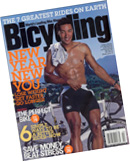by Larry Freund
Although bicycles are a big business in the United States, with annual retail sales of more than five-billion dollars, U.S. bicycle manufacturing has been declining. But a small company near Boston, Massachusetts, is reversing that trend, and perhaps pointing the way to the future of manufacturing. Correspondent Larry Freund reports from New York.
Freund: An old garment factory in Watertown, Massachusetts, is the home now of Seven Cycles Incorporated, a company founded by entrepreneur Rob Vandermark in 1997, when he was 29. His concept was simple: building custom-made bicycle frames from lightweight titanium rods, using a manufacturing technique called single piece flow.
Vandermark: It is the idea of making what the customer needs in the quantity that they need it at the time that they need it. And for Seven, that is when a customer calls. They are almost invariably ordering one bike at a time, so we can only make one at a time. So that the piece—in this case it is a bike frame—one piece or one frame flows through the system at a time. So rather than somebody working on a thousand parts in a machining process, they will work on one part until it is complete and then start on the next part.
Freund: Mr. Vandermark says people in the industry thought it was a big mistake to start his company, with so many of the bicycles now sold in the United States imported from such countries as China. But Internet commerce specialist Evan Schwartz says Seven Cycles may be a model for future industry.
Schwartz: This is really an overturn of mass production, which started with the industrial revolution over 200 years ago. And it used to be that you would make the product and then sell the product. Now, on the Web, the customers construct their own personalized product. They pay for it and then you, as the manufacturer, produce it. This company called Seven Cycles started taking orders from people over the phone and getting their measurements and the type of terrain they ride on, producing a custom frame and mailing it out to the customer [retailer]. And this has led to them being the biggest custom bike builder in the U.S.
Freund: The manufacturing process at Seven Cycles is described by Business Week magazine editor Joyce Barnathan as mass customization.
Barnathan: There is a lot less waste if you know exactly what your consumer wants and you provide it. And you do not have to carry the inventory. And in fact, in some cases you do not even have to have capital, because the consumer will pay up front (in advance) exactly for the product that he or she wants at the moment.
Freund: For the Seven Cycles company, the manufacturing formula has meant success. Founder Rob Vandermark says the firm expects to produce 16-hundred bicycle frames by the end of this year and is expanding into related component parts.
Vandermark: Each year, we have exceeded our projections on almost every front: for revenue and profit and units shipped and labor-hours per frame. It could not have been going better. The bike industry is a very competitive industry. There are a lot of small, one-man builders that do it because they love it. So it is a very passionate industry. And it is always difficult to make a living in a passionate industry.
Freund: The bicycle maker maintains a network of retailers and distributors in Europe and Asia, and hopes to double the proportion of its sales outside the United States from 15 percent to 30 percent.


